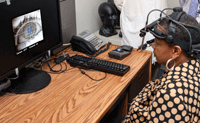 Q: I have been reading about ocular tremors as a sign for Parkinson’s disease. Can you tell me more?
Q: I have been reading about ocular tremors as a sign for Parkinson’s disease. Can you tell me more?
A: “In addition to the more well-known characteristics of resting tremor, rigidity and bradykinesia, Parkinson’s disease can also affect the ocular motor system,” says Denise Goodwin, O.D., Associate Professor of Optometry and Coordinator of the Neuro-ophthalmic Disease Clinic at Pacific University College of Optometry, in Oregon.
“Because Parkinson’s disease is a common disorder that can cause impaired visual function, we are likely to see these patients in our offices,” she says. “So, it’s important to be familiar with this condition and the ocular consequences.”
Several studies have looked at ocular motor movement in people with Parkinson’s disease. One recent study—the largest of its kind—found fixation instability in all 112 Parkinson’s patients.1 Of these, 63% had an amplitude significant enough to affect their vision. In comparison, just two of the 60 control subjects demonstrated a similar eye movement pattern. Interestingly, after being followed for two years, one of these two controls developed additional non-ocular parkinsonian features.
“The fact that the ocular tremor was found in every subject with Parkinson’s disease, as well as one control subject who later developed parkinsonian features, suggests that this testing may become useful in diagnosing Parkinson’s disease,” Dr. Goodwin says.
The eye tremors discussed in this study are too minute to be detected at the slit lamp. Special eye tracking equipment is needed. The testing instrument used in this study is a “research-grade” device (Eyelink II, SR Research), and is not likely to be found in most eye doctors’ offices. So, whether such testing will soon become part of the comprehensive ophthalmic exam remains to be seen.
“If this study is validated, eye movement recording devices may become more common in optometric practices and allow earlier diagnosis of Parkinson’s,” Dr. Goodwin says. “Because patients are more likely to see an optometrist on a regular basis than a neurologist, optometry would be in an ideal position to identify these patients.”
Q: What other motility and eye disorders should I look for?

A subject with Parkinson’s undergoes video eye tracking to measure ocular tremor.
A: “Another common ocular motor disorder associated with Parkinson’s disease is convergence insufficiency,” Dr. Goodwin says. “This can result in diplopia at near and reading difficulties. It can be treated with single-vision reading glasses with prism, but may be difficult to treat because of fluctuation.”
Other ocular motor abnormalities include hypometric saccades, saccadic pursuit movements, square-wave jerks and limitation of up-gaze.
“Eyelid disorders commonly associated with Parkinson’s disease include blepharospasm, apraxia of eyelid opening, and decreased blink rate resulting in dry eye symptoms, which is the most common ocular symptom among these patients,” Dr. Goodwin says. In addition, be aware that up to one-fourth of these patients experience visual hallucinations.2
“Comanagement with a neurologist will help give these patients the best treatment,” Dr. Goodwin adds. “Currently, double vision or irregular eye movements in conjunction with classic signs of Parkinson’s disease, such as tremor or ‘pill-rolling’ movements, should prompt a consultation with the neurologist. Once diagnosed, management of the double vision with prism or vision therapy, as well as dry eye treatment, will help alleviate patient symptoms.”
1. Gitchel GT, Wetzel PA, Baron MS. Pervasive ocular tremor in patients with Parkinson disease. Arch Neurol. 2012 Apr 9 [epub ahead of print].
2. Biousse V, Skibell BC, Watts RL, et al. Ophthalmologic features of Parkinson’s disease. Neurology. 2004 Jan 27;62(2):177-80.

